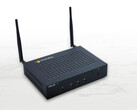1. Hall-effect triggers and joysticks
One of the biggest gripes relating to the current crop of gaming handhelds is the use of regular analogue triggers and joysticks, which tend to suffer from drift over time. The MSI Claw A1M makes use of hall-effect joysticks and triggers, which both increases the device's resistance to joystick drift, but it allows players to fine-tune their controller sensitivity.
The Lenovo Legion Go (curr. $699.99 on Amazon), which we recently reviewed, solves this by using hall-effect joysticks, and the Asus ROG Ally makes use of hall-effect triggers, addressing customisability, but the Claw is the only handheld so far that uses both hall effect joysticks and triggers.
2. Thunderbolt 4
In a gaming handheld, performance often understandably takes a backseat to portability, battery life, and ergonomics, but there might be times when gamers want to play games with higher graphical fidelity that the iGPU simply can't handle. In those cases, an external GPU enclosure is an almost-ideal solution.
Given it uses an Intel CPU, the MSI Claw's USB Type-C port is certified for Thunderbolt 4, giving it transfer speeds of up to 40 Gbps. Not only that, but compatibility with other Thunderbolt 3 and 4 devices is basically guaranteed, while USB's mishmash of features is a veritable minefield of compatibility hazards.
While the USB4 ports some AMD-powered gaming handhelds use are theoretically capable of the same bandwidth as Thunderbolt 3, anyone hoping to get the best performance out of an eGPU enclosure, like the Razer Core X (curr. $365.51 on Amazon) is better off with Thunderbolt 4 for its support for 32 Gbps of PCIe bandwidth.
Better support for these eGPU enclosures dramatically expands the graphics capabilities of a Steam Deck killer device like the MSI Claw and allows owners to theoretically replace a full-fat desktop PC with the handheld and a small desktop enclosure.
3. The Intel Arc 8-Core iGPU is impressive
In terms of graphical performance, the Intel Arc 8-core iGPU found in the Intel Core Ultra 7 155H has also proven itself to be a rather capable little chip, scoring only slightly behind the Nvidia GeForce RTX 3050 Ti Laptop GPU in some scenarios. Continued work on Arc drivers also shows promise for both feature support and performance improvements.
Intel's Arc iGPUs also support a number of AI-powered features supported by the on-board NPU. While performance is going to vary depending on the game, features like XeSS and Ray Tracing should make games look significantly better — especially at lower resolutions.
Support for AV1 encoding could also be a game-changing feature for in-game recording and streaming, thanks to its improved efficiency that will prove vital on a less powerful device.
4. Intel CPU customisation could offer significant efficiency benefits
Much of the discussion — both praise and criticism — around the Claw has been regarding the Intel Core Ultra 7 155H processor that MSI plans to use for the device. While some criticism, like spotty support for older titles and emulators, is valid, the processor and iGPU pairing presents some interesting possibilities when it comes to efficiency and running undemanding tasks and games.
In case you were unaware, the Intel Core Ultra 7 155H is a 16-core processor comprised of six performance cores, eight efficiency cores that top out at 3.8 GHz, and two low-power efficiency cores, for a total of 22 threads. Of those, the performance cores are the only ones with hyper threading. The cores also have different boost frequencies, with p-cores running at 1.4 GHz–4.8 GHz, e-cores clocking 900 MHz–3.8 GHz, and the low-power e-cores sipping power at just 700 MHz–2.5 GHz.
This weird mix of cores enables weird configurations like disabling all but the performance cores for demanding games or using the efficiency cores in combination with the low-power efficiency cores to run something that puts almost no strain on the CPU.
In conjunction with Intel's Thread Director, the built-in NPU, and MSI's AI-enhanced Center M to allow users to customise their CPU and power configurations, the MSI Claw could become a very flexible handheld gaming powerhouse. Enabling and disabling cores on an as-needed basis may be necessary for the MSI Claw to reach the same efficiency levels as the AMD Ryzen Z1 Extreme that forms the backbone of other Windows handhelds.
















